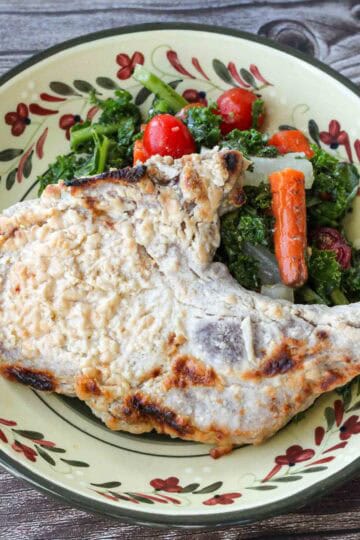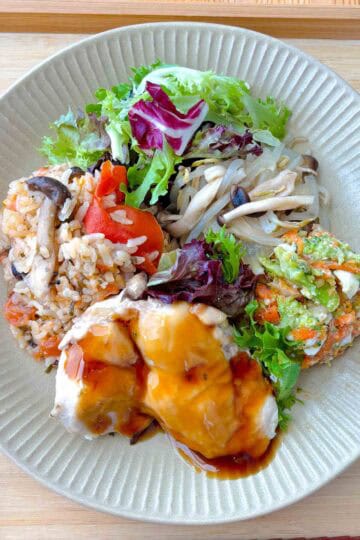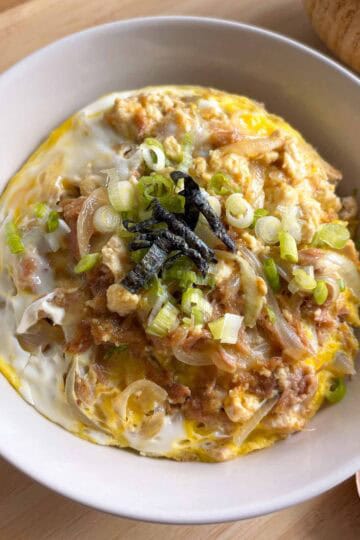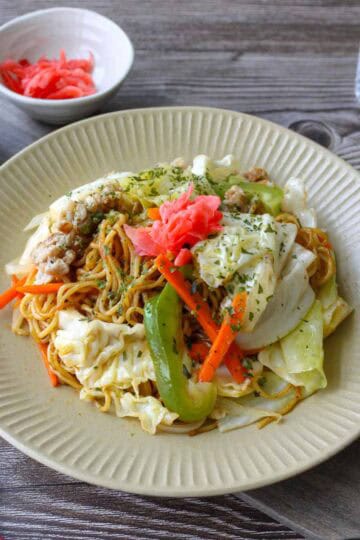Quick and flavorful abura soba made with simple ingredients! Sweet, savory, tangy sauce pairs perfectly with scallions, sesame, and toppings.

The sauce is sweet, tangy, and full of flavor, especially with the scallion and sesame topping. Plus, you can switch things up by adding more toppings and seasonings as you eat!
My husband loves this one since he’s not a fan of soup (he calls it flavored water—I’ll never understand! 😂). No broth means no fuss—just mix the sauce, toss the noodles, and dig in!
This recipe is inspired by Tokyo Abura Soba (東京油組総本店), so if you ever find yourself in Japan, definitely check out their restaurant! 😊
Why You'll Love This Recipe
- Easy & Quick: Just mix the sauce, boil the noodles, and you're done! It's simple but packed with flavor and totally satisfying🙂
- Fun and Customizable: Abura soba is meant to be adjusted at the table, so no stress about making it perfect for everyone. Let each person tweak the flavor to their liking—it’s fun to share and compare, too!
- Light and Refreshing: Despite the name abura soba (abura means oil in Japanese), it’s not greasy at all! The vinegar gives it a refreshing kick that keeps it light and balanced.
Notes on Ingredients
See the recipe card for the full ingredients list.

- Chinese noodles: The noodles I used were about 3.5 ounces (100g) per serving, so feel free to adjust the sauce based on your noodle amount. Also, I highly recommend using thick, fresh noodles instead of dried ones—this dish is all about the noodles, so you want that perfect chewy texture!
- Bonito flakes: Adds a nice fishy umami kick, almost like a ramen broth.
- Ajitama (ramen egg): You can use a regular boiled egg instead, but if you want that delicious marinated flavor, check out my not-too-salty ajitama recipe!
Substitutions and Variations
- Gluten-Free Version: Swap in gluten-free noodles and soy sauce. I couldn't find any gluten-free Chinese noodles though, so that's something to keep in mind!
- Vegan Version: Use vegan dashi powder, vegan oyster sauce, and plant-based toppings like tofu, nori seaweed, and shiitake mushrooms for a delicious, meat-free alternative.
- Toppings: Abura soba is all about making it your own, so get creative and customize it however you like! Here are some ideas:
- Nori seaweed
- Menma (fermented bamboo shoots)
- Chashu (braised pork)
- Japanese mayonnaise
- Parmesan cheese
- Scallions and ground sesame mix
- Garlic paste
- Egg (egg yolk, raw, onsen tamago, ajitama (ramen egg))
- Leeks (white part)
- Yuzu kosho (yuzu pepper paste)
- Chili crisps
- Layu (Japanese chili oil)
How to Make Abura Soba

Step 1: Microwave the bonito flakes, then rub them between your hands to turn them into a powder

Step 2: Mix the minced scallions with ground sesame seeds

Step 3: In a bowl, combine all the sauce ingredients and divide them into individual serving bowls. Add the bonito powder to each bowl

Step 4: Place cooked noodles in the bowl with the sauce, add your toppings, and enjoy while it’s hot!
Kurumi's Tips
- Choose Good Noodles: Abura soba is all about enjoying the quality of the noodles, so make sure to go for thick, fresh noodles instead of dry ones. The noodles are the star of the dish!
- Eat While Hot: Don't wait for it to cool down! This dish tastes way better when it's hot, so mix everything together (as I’ll explain below) and dig in right away!
How to Eat Abura Soba
Here’s how to enjoy abura soba the traditional way:
- Mix the dressing and noodles well while they’re still hot.
- As you eat, add vinegar, chili oil, or any other toppings you like to change up the flavors.
- And don’t forget—eat it while it’s hot!

Storage Instructions
- Sauce: Keep it in an airtight container in the fridge, and it'll stay good for 3–4 days.
- Cooked Noodles: Best to eat them fresh—storing them will just make them soggy.
- Bonito Powder: Store it in an airtight container in the fridge, and it’ll last up to a week.
- Scallion & Sesame Mix: This will stay fresh for 1–2 days in the fridge, sealed in an airtight container.
FAQs
Abura soba is a brothless ramen dish with a simple soy sauce and oil-based sauce. It originated in Tokyo around 1950 and is so easy to make that some call it “lazy noodles” 😂
Abura means oil in Japanese, and while traditional recipes use lard, I swapped it for sesame oil to keep it lighter. But don’t worry—it’s not greasy at all and actually lower in calories than ramen!
And despite the name soba, it doesn’t use soba noodles—back in the day, Japanese people called Chinese-style ramen noodles soba, and the name just stuck!
Abura soba keeps it simple with minimal toppings, letting the noodles shine.
Maze soba, on the other hand, is loaded with toppings—like minced meat—making it a heartier dish. Funny enough, one popular version, Taiwanese maze soba, actually comes from Nagoya, Japan, not Taiwan!
More Japanese Main Dish Recipes
Looking for other recipes like this? Try these:
💌 If you tried this recipe and liked it, I’d love to hear from you! Leave a comment and review below, or send a photo of your dish to my email. I’d be so happy to see your creation!
📖Recipe

Abura Soba (Soupless Japanese Oil Ramen, Ready in 20 Minutes!)
Ingredients
Method
- Start by boiling water in a large pot.
- Make the bonito powder: Add ½ cup bonito flakes to a microwavable bowl and heat for 1 minute until they dry out. Rub them with your hands to turn them into powder. Set aside.
- Make the scallions and sesame mix: Pulse ¼ cup toasted white sesame seeds in a food processor until finely ground. Then stir in ¼ cup minced scallions with a spoon. Try to mince the scallions as finely as you can so they blend nicely with the noodles. Set that aside for now.
- Make the sauce: Mix 2.5 tablespoons oyster sauce, 1 tablespoon rice vinegar, and 1 tablespoon sesame oil. Divide the sauce into bowls and add 1 teaspoon of bonito powder to each.
- Prepare the toppings: Get your toppings ready—whatever you like!
- Boil the noodles: Once the water is boiling, cook 2 bundles Chinese noodles as per the package instructions. Drain them when done.
- Assemble: Divide the noodles into bowls, add your favorite toppings, and dig in while it’s hot (see Note 4)! Feel free to switch up the flavors as you go. If you're into sour like I am, try adding ½ to 1 teaspoon (or more!) of vinegar while you eat. Craving some heat? Add a little ra-yu or chili crisp. Have fun with the toppings and mix things up—perfect for when you want a little variety 🙂
Notes
- (Note 1) Chinese noodles: I used about 3.5 ounces (100g) of noodles per serving, so adjust the sauce based on how many noodles you’re using. And definitely go for thick, fresh noodles—this dish is all about that chewy texture!
- (Note 2) Ajitama (ramen egg): If you want to make ajitama (ramen egg), check out my not-too-salty ajitama recipe!
- (Note 3) Toppings: Abura soba is all about customization, so feel free to get creative with toppings like nori, menma, chashu, Japanese mayo, parmesan, and more. You can even add garlic paste, yuzu kosho, chili oil, or chili crisps for extra flavor!
- (Note 4) How to Eat: To enjoy abura soba the traditional way, mix the dressing and noodles while they’re hot, then add vinegar, chili oil, or any toppings you like as you eat. And remember—eat it while it’s hot!
- Sauce: Keep it in an airtight container in the fridge, and it'll stay good for 3–4 days.
- Cooked Noodles: Best to eat them fresh—storing them will just make them soggy.
- Bonito Powder: Store it in an airtight container in the fridge, and it’ll last up to a week.
- Scallion & Sesame Mix: This will stay fresh for 1–2 days in the fridge, sealed in an airtight container.
📌Pin This Recipe For Later!











Kurumi says
I know—it’s a carb-heavy meal, but sometimes you just need something like this to feed your soul! My husband actually said he likes it more than regular ramen because it’s not oily or heavy. Plus, it’s super easy to make, so I’m excited for him to try making it on his own 🙂 It’s made with simple ingredients but full of flavor—I already can’t wait to have it again!